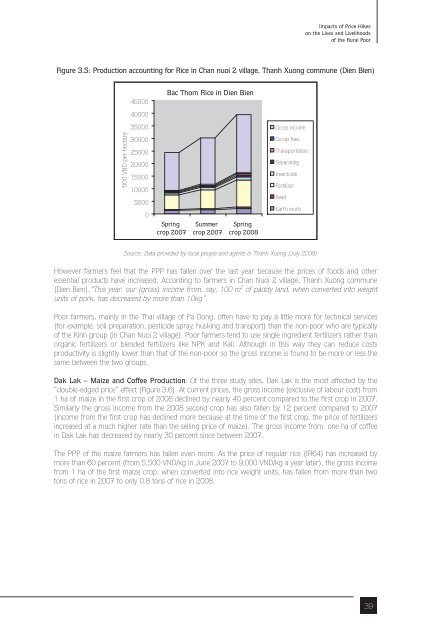Untitled - Oxfam Blogs
Untitled - Oxfam Blogs
Untitled - Oxfam Blogs
You also want an ePaper? Increase the reach of your titles
YUMPU automatically turns print PDFs into web optimized ePapers that Google loves.
Impacts of Price Hikes<br />
on the Lives and Livelihoods<br />
of the Rural Poor<br />
Figure 3.5: Production accounting for Rice in Chan nuoi 2 village, Thanh Xuong commune (Dien Bien)<br />
'000 VND per hectare<br />
45000<br />
40000<br />
35000<br />
30000<br />
25000<br />
20000<br />
15000<br />
10000<br />
5000<br />
0<br />
Bac Thom Rice in Dien Bien<br />
Spring<br />
crop 2007<br />
Summer<br />
crop 2007<br />
Spring<br />
crop 2008<br />
Gross income<br />
Co-op fees<br />
Transportation<br />
Separating<br />
Insectcide<br />
Fertilizer<br />
Seed<br />
Earth work<br />
Source: Data provided by local people and agents in Thanh Xuong (July 2008)<br />
However farmers feel that the PPP has fallen over the last year because the prices of foods and other<br />
essential products have increased. According to farmers in Chan Nuoi 2 village, Thanh Xuong commune<br />
(Dien Bien),“This year, our (gross) income from, say, 100 m 2 of paddy land, when converted into weight<br />
units of pork, has decreased by more than 10kg”.<br />
Poor farmers, mainly in the Thai village of Pa Dong, often have to pay a little more for technical services<br />
(for example, soil preparation, pesticide spray, husking and transport) than the non-poor who are typically<br />
of the Kinh group (in Chan Nuoi 2 village). Poor farmers tend to use single ingredient fertilizers rather than<br />
organic fertilizers or blended fertilizers like NPK and Kali. Although in this way they can reduce costs<br />
productivity is slightly lower than that of the non-poor so the gross income is found to be more or less the<br />
same between the two groups.<br />
Dak Lak – Maize and Coffee Production. Of the three study sites, Dak Lak is the most affected by the<br />
“double-edged price” effect (Figure 3.6). At current prices, the gross income (exclusive of labour cost) from<br />
1 ha of maize in the first crop of 2008 declined by nearly 40 percent compared to the first crop in 2007.<br />
Similarly the gross income from the 2008 second crop has also fallen by 12 percent compared to 2007<br />
(income from the first crop has declined more because at the time of the first crop, the price of fertilizers<br />
increased at a much higher rate than the selling price of maize). The gross income from one ha of coffee<br />
in Dak Lak has decreased by nearly 30 percent since between 2007.<br />
The PPP of the maize farmers has fallen even more. As the price of regular rice (IR64) has increased by<br />
more than 60 percent (from 5,500 VND/kg in June 2007 to 9,000 VND/kg a year later), the gross income<br />
from 1 ha of the first maize crop, when converted into rice weight units, has fallen from more than two<br />
tons of rice in 2007 to only 0.8 tons of rice in 2008.<br />
39

















